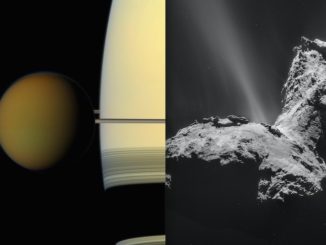
DARMSTADT, Germany — This week marks the pinnacle of the professional careers of many scientists, when the European Space Agency plans to put down a three-legged robotic lander on a comet, a risky first-of-a-kind endeavor that could rewrite textbooks on the history of the solar system.
The landing of Philae — a spacecraft about the size of a kitchen oven — is scheduled for Wednesday after a perilous seven-hour descent from Europe’s Rosetta orbiter, which arrived at comet 67P/Churyumov-Gerasimenko in August.
“I think this is the key week of our professional careers,” said Andrea Accomazzo, Rosetta’s flight director at the European Space Operations Center here. “I don’t think we will land on a comet any other time (in our careers).”
The lander has been feeding off of Rosetta’s power supplies since the missions launched together in March 2004, but Philae will cut the umbilical and fly free of its mothership Wednesday.
Release is scheduled for 0903 GMT (4:03 a.m. EST) Wednesday in “Earth time.” The real event will occur more than 28 minutes earlier, but it takes nearly a half-hour for radio signals to cover the distance between Earth and Rosetta.
Confirmation of landing on the comet is expected around 1600 GMT (11 a.m. EST), but officials say the time could vary by a few minutes due to uncertainties in Philae’s trajectory.
The landing is the culmination of three months of feverish surveys, scientific and engineering reviews and decisions to settle on an acceptable touchdown zone for Philae.
The selected site is named Agilkia after an island in the Nile River in Egypt, and although the region is deemed the safest on the comet for landing, it contains some boulders and slopes that could spell trouble for Philae.
The Agilkia site sits on the smaller of the comet’s two lobes — the “head” of the rubber duck descriptor often used to describe the comet’s shape. Comet 67P/Churyumov-Gerasimenko is about the size of a small city.
“We’ve put all the effort we could put into this activity,” Accomazzo said. “There’s still a lot in front of us. There are many things that depend on what we are going to do in the net couple of days, and there are a couple of things that do not depend at all on what we do. For example, where we touch down. We cannot select a single spot where we touch down. We need to be a bit lucky.”
Scientists have plans for Philae and Rosetta to work in tandem over the next few months studying the comet, sniffing and tasting its chemical components, and looking for signs of water and organics that could have been essential to the emergence of life on Earth.
The lander has a 64-hour battery lifetime, but it could run on solar power until spring, when it is expected to overheat as the comet nears the sun.
Rosetta will continue flying around the comet until at least the end of 2015, collecting its own independent measurements.
“This week marks an epoch in the mission,” said Matt Taylor, ESA’s project scientist for the Rosetta mission. “Once this week has passed we start the full science phase. It’s all about science then. Up to now, we have been doing science on the side enabling landing site decisions and characterization of the comet.”
The lander was set to be activated late Monday, according to Stephan Ulamec, who leads the Philae team at DLR, the German Aerospace Center.
“We will start with warming it up, and then in the following hours we will prepare it for separation and descent,” Ulamec said. “For the moment everything is go. The commands are uploaded, and the lander is ready to be ejected on Wednesday in the early morning and land later in the afternoon (European time).”
Sylvain Lodiot, Rosetta’s spacecraft operations manager, said ground controllers here would begin 24-hour shifts Tuesday and stay on console around the clock through the weekend.
“The two teams doing this shiftwork in flight dynamics have done massive work in the last few days, and I think we’re ready,” Lodiot said.
Follow Stephen Clark on Twitter: @StephenClark1.



